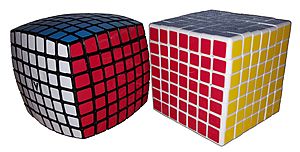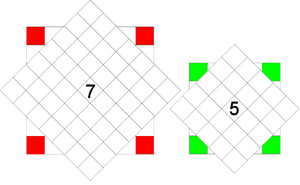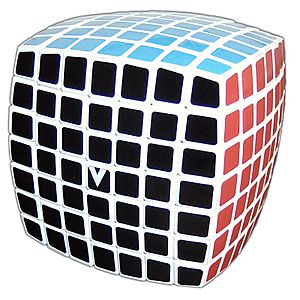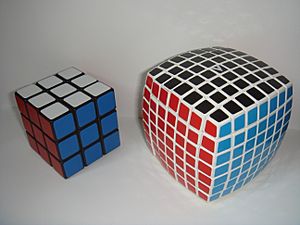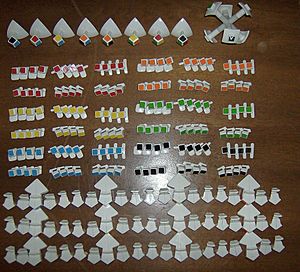V-Cube 7 facts for kids
The V-Cube 7 is a large combination puzzle shaped like a 7x7x7 cube. It's similar to the famous Rubik's Cube, but much bigger! The first V-Cube 7 to be sold widely was invented by Panagiotis Verdes from Greece. His company, Verdes Innovations SA, still makes them. Other companies, mostly from China, also make 7x7x7 cubes. Some of these newer cubes have improved designs. Like the 5x5x5 cube, the V-Cube 7 has both fixed (staying in place) and movable center pieces.
Contents
How the V-Cube 7 Works
This puzzle has 218 unique small pieces on its surface, called "cubies." Six of these pieces are in the very center of each face. They are attached to an inner frame and stay in the same spot compared to each other. The V-Cube 6 uses a similar design, but its central parts are hidden.
There are 150 center pieces, each showing one color. There are 60 edge pieces, each showing two colors. And there are eight corner pieces, each showing three colors. Every piece has a special color mix. For example, you won't find a piece with both red and orange, because red and orange are on opposite sides when the cube is solved. You can mix up the cube by twisting its outer layers 90, 180, or 270 degrees. But the colors on the solved cube always stay in the same order.
V-Cube 7s are usually made with white plastic. The colors are red opposite orange, blue opposite green, and yellow opposite black. Some cubes are made with black plastic and a white face. You can also find solid plastic versions where the plastic itself is the color, without stickers. The fixed center piece, usually black or white, has the company's logo. For Verdes cubes, it's a 'V'. Verdes also sells cubes with flag designs, like Germany or Poland.
Unlike the flat-sided V-Cube 6, the V-Cube 7 is noticeably rounded. This rounded shape is important! The way the puzzle works needs the outer layers to be thicker than the inner ones. If all layers were the same thickness, the corner pieces would lose contact when you turn a side. The V-Cube 6 and V-Cube 7 both solve this by making the outer layers thicker. The rounded shape of the V-Cube 7 helps hide this difference in thickness. Other companies also make 7x7x7 cubes, and they all use thicker outer layers, whether their cubes are rounded or flat.
How Many Ways Can You Mix It Up?
The V-Cube 7 has 8 corner pieces, 60 edge pieces, and 150 center pieces (6 fixed, 144 movable).
You can arrange the corner pieces in many ways. The edge pieces can also be moved around. The center pieces, even though there are many, can only be moved within their own groups.
When you put all these possibilities together, the total number of ways to scramble a V-Cube 7 is incredibly huge! It's about 19,500,551,183,731,307,835,329,126,754,019,748,794,904,992,692,043,434,567,152,132,912,323,232,706,135,469,180,065,278,712,755,853,360,682,328,551,719,137,311,299,993,600,000,000,000,000,000,000,000,000,000,000,000. That's a number with 160 digits! It's so big, it's hard to even imagine.
One of the fixed center pieces usually has the manufacturer's logo, like the 'V' on a V-Cube. This center piece can be turned in four different ways. However, most people consider the cube solved no matter which way the logo is facing.
How to Solve the V-Cube 7
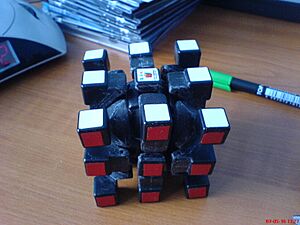
One popular way to solve the V-Cube 7 is to first group similar edge pieces together to form solid strips. Then, you group the center pieces to make solid colored blocks. Once you've done this, the cube acts much like a regular 3x3x3 cube. You can then use the same solving methods you would use for a smaller cube. This method helps avoid certain "parity errors" that can happen on other large cubes like the 4x4x4 or 6x6x6.
Another way to solve it is to focus on the edge pieces first. You can place the corner pieces just like you would on any other cube puzzle. The center pieces are then solved using a method similar to the one used for the 4x4x4 cube.
World Records
People who solve puzzles very quickly are called speedsolvers. They compete to see who can solve cubes the fastest!
The world record for solving a 7x7x7 cube in a single try is 1 minute and 40.89 seconds. This amazing time was set by Max Park from the United States on August 1, 2019.
Max Park also holds the world record for the fastest average time of three solves. He solved the 7x7x7 in an average of 1 minute and 46.57 seconds on January 25, 2020.
Top 5 Fastest Solvers (Single Solve)
| Name | Fastest solve | Competition |
|---|---|---|
| Max Park | 1:40.89 | CubingUSA Nationals 2019 |
| Feliks Zemdegs | 1:53.62 | Australian Nationals 2018 |
| Aryan Kejriwal | 1:54.62 | Providence Fall 2019 |
| Kevin Hays | 1:56.70 | Southern Championship 2019 |
| Ciarán Beahan | 1:56.89 | Weston-super-Mare Open 2019 |
Top 5 Fastest Solvers (Average of 3 Solves)
| Name | Fastest average | Competition |
|---|---|---|
| Max Park | 1:46.57 | Houston Winter 2020 |
| Feliks Zemdegs | 2:00.63 | Australian Nationals 2018 |
| Ciarán Beahan | 2:02.04 | Weston-super-Mare Open 2019 |
| Seung Hyuk Nahm (남승혁) | 2:05.08 | Daegu Autumn Open 2019 |
| Kevin Hays | 2:05.70 | Rose City 2018 |
See also
 In Spanish: V-Cube 7 para niños
In Spanish: V-Cube 7 para niños


